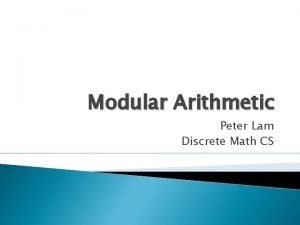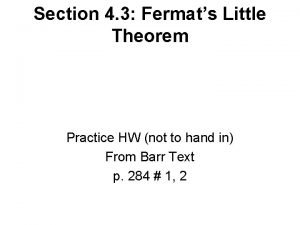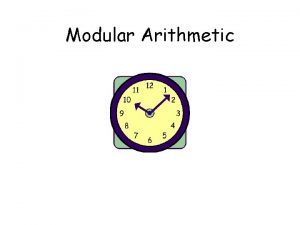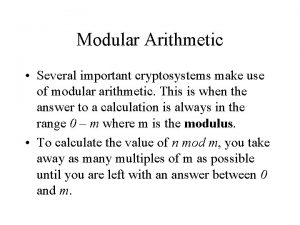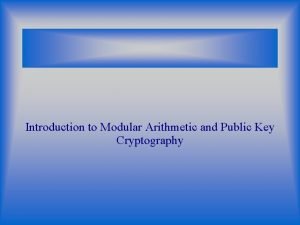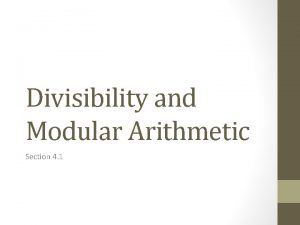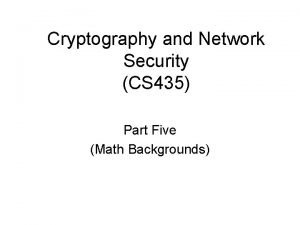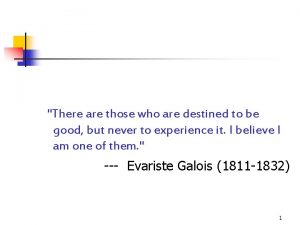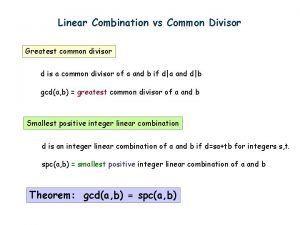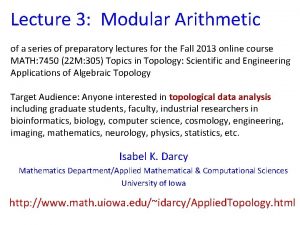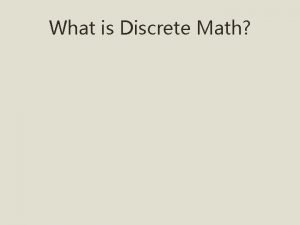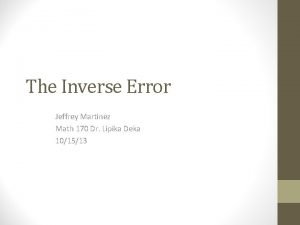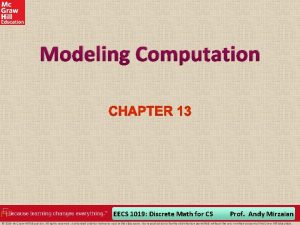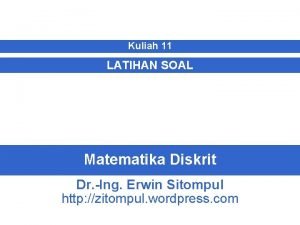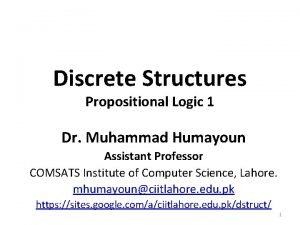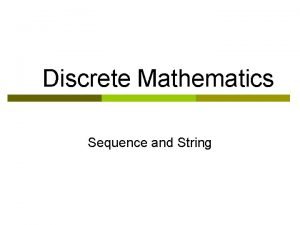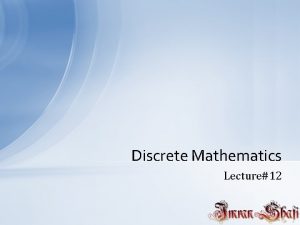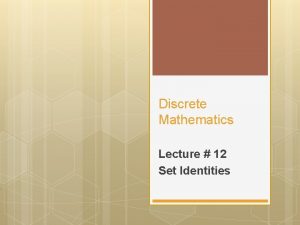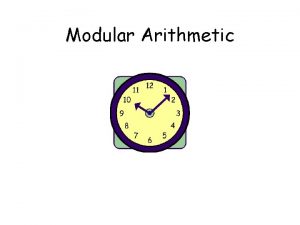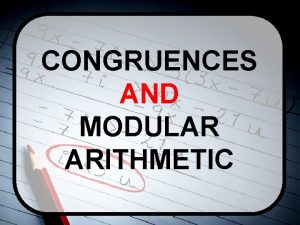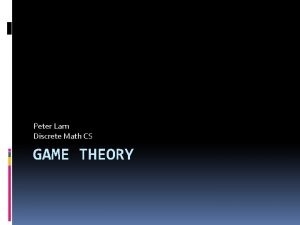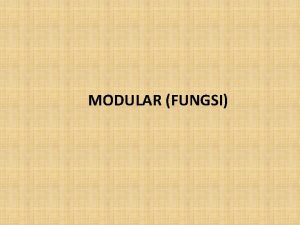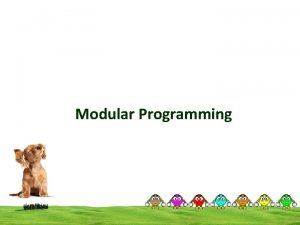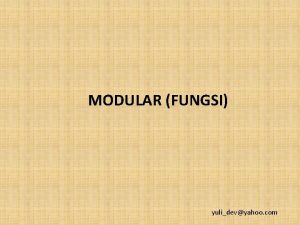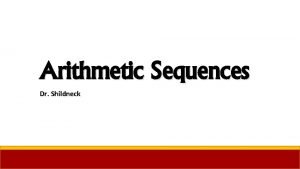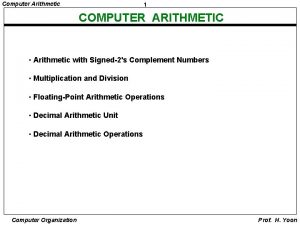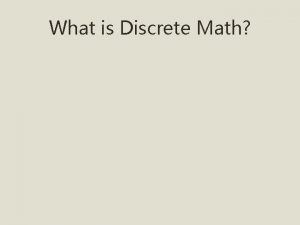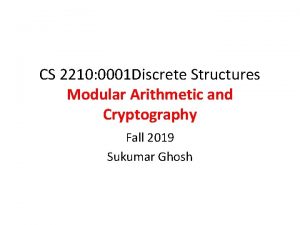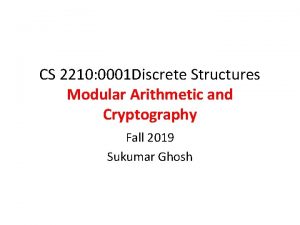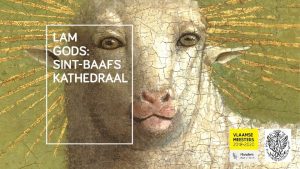Modular Arithmetic Peter Lam Discrete Math CS Introduction



















- Slides: 19

Modular Arithmetic Peter Lam Discrete Math CS

Introduction to Modular Arithmetic � Sometimes Referred to Clock Arithmetic � Remainder is Used as Part of Value ◦ i. e Clocks � 24 Hours in a Day However, Time is Divided to Twelve Hour Periods � 22 Hours is 12 + 10 or Ten O'clock

Intro. To Modular Arithmetic (Cont. ) � Modular represents what to divide a number by and that remainder is the result � Any integer will work for Modular n � Is used to simplify equations

Congruence Relation � Equivalence Relation or Algebraic Structure that is Compatible with the Structure � If a-b is divisible by n or remainder is same when divided by n ◦ Example: 37 ≣ 57

Example Explanation � 57 -37 = 20 or multiple of 10 � 37/10 = modulo 7 � 57/10 = modulo 7 � Remainders are the Same

Modular Arithmetic w/Mod 2 � Let 0 represent even numbers � Let 1 represent odd numbers � After Some Minor Calculations We Obtain ◦ 0 × 0 ≡ 0 mod 2, Multiplication of Two Even Numbers Result in Even Numbers ◦ 0 × 1 ≡ 0 mod 2, Multiplication of Odd and Even Numbers Result in Even Numbers ◦ 1 × 1 ≡ 1 mod 2, Multiplication of Two Odd Numbers Result in Odd Numbers

Mod 2 Solving Equations � Example ◦ ◦ 2 a – 3 = 12 0 * a – 1 = 0 mod 2 According to the Calculations Aforementioned (1 = 0 ≠ 1 × 1 ≡ 1 mod 2) � 1 ≢ 0 Therefore There is No Integer Solution for 2 a – 3 = 12

Properties of Congruence � Reflexivity: a ≡ a mod m. � Symmetry: If a ≡ b mod m, then b ≡ a mod m. � Transitivity: If a ≡ b mod m and b ≡ c mod m, then a ≡ c mod m.

Practical Applications � Finding Greatest Common Divisor � Number Theory � Simplifying Extensive Calculations � Cryptography ◦ Directly Underpins Public Key Systems ◦ Provides Finite Fields which Underlie Elliptic Curves � Used in Symmetric Key Algorithms – AES, IDEA, RC 4

Greatest Common Divisor denoted as GCD � To find GCD � Commonly ◦ Identify minimum power for each prime ◦ If prime for number a is , and prime for number b is , ◦ Then

Example � Find the GCD of 5500 and 450 � Prime Factorization of Both 5500 and 450 ◦ 5500 = 22, 30, 53, 111 ◦ 450 = 21, 32, 52, 110 � Determine Two The minimum number between the

Example (Cont. ) � 22 > 21 Therefore 21 is used � 30 < 32 Therefore 30 is used � 53 > 52 Therefore 52 is used � 111 > 110 Therefore 110 is used � The equation for GCD then becomes ◦ 21 * 30 * 52 * 110 = 50 ◦ GCD of 5500 and 450 is 50

Powers and Roots � ab (mod n) � If b is a large integer, there are shortcuts � Fermat’s Theorem

Fermat’s Theorem � If ab (mod n) = 1 ◦ If p is prime and greatest common divisor (a, p) = 1, then, Zp ◦ a(p-1) = 1 � Example 1014=1 in Z 13 � Z is a set that represents ALL whole numbers, positive, negative and zero

Cryptography � Modular Arithmetic is a Common Technique for Security and Cryptography � Two types of Cryptography ◦ Symmetric Cryptography ◦ Asymmetric Cryptography � Refer to Cryptography Powerpoint for Review

Elliptic Curve Cryptography � Use Elliptic Curve for Asymmetry Cryptography � Point Multiplication ◦ ◦ = k. P, k is integer and P is Point on Elliptic Curve K is defined as elliptic curve over finite field Finite Field is consisted of Modular Arithmetic More Advanced – 2 Finite Fields (Binary Fields)

Finite Field in Elliptic Curve Crytography � Finite Field is a set of numbers and rules for doing arithmetic with numbers in that set � Based off Modular Arithmetic � Can be added, subtracted, multiplied and divided � Members of finite field with multiplication operation is called Multiplicative Group of Finite Field

In General � Modular Arithmetic is Used ◦ To simplify simultaneous equations ◦ Simplify extensive calculations ◦ Cryptography and finite fields � There are Many More Applications with Modular Arithmetic

Sources � http: //www. cut-the- knot. org/blue/examples. shtml � http: //mathworld. wolfram. com/Congruence. html � http: //www. math. rutgers. edu/~erowland/mo dulararithmetic. html � http: //www. deviceforge. com/articles/AT 4234 154468. html � http: //www. securityarena. com/cissp-domain -summary/63 -cbkcryptography. html? start=3
 Modular arithmetic discrete math
Modular arithmetic discrete math Bacaan alif lam qamariyah dibaca dengan
Bacaan alif lam qamariyah dibaca dengan Fermat's little theorem
Fermat's little theorem Modular arithmetic laws
Modular arithmetic laws Modular arithmetic
Modular arithmetic Modular arithmetic
Modular arithmetic Divisibility and modular arithmetic
Divisibility and modular arithmetic Gcd(1970,1066)
Gcd(1970,1066) Is modulo distributive
Is modulo distributive Gcd vs gcf
Gcd vs gcf Modular arithmetic
Modular arithmetic Discrete mathematics
Discrete mathematics Inverse error fallacy
Inverse error fallacy Modeling computation discrete math
Modeling computation discrete math What are ps and qs
What are ps and qs Soal matematika diskrit dan jawabannya
Soal matematika diskrit dan jawabannya Discrete math propositional logic
Discrete math propositional logic Discrete mathematics sequences
Discrete mathematics sequences Irreflexive relation in discrete mathematics
Irreflexive relation in discrete mathematics Identity law discrete math
Identity law discrete math
